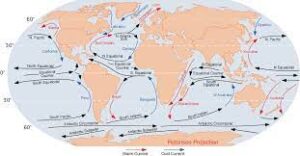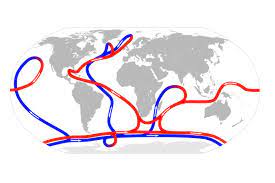The oceans play a crucial role in shaping the Earth’s climate and ecosystems, and oceanic current is an integral part of this process. These currents, which are driven by a variety of factors, are a constant flow of water that circulate throughout the ocean, carrying heat, salt, and other important elements. In this article, we will explore the causes, effects, and importance of oceanic currents in depth.

Table of Contents
Causes of Oceanic Currents
Oceanic currents are caused by a variety of factors, including winds, tides, and differences in water density. Wind-driven currents occur when wind blows across the surface of the ocean, causing water to move in response. Tidal currents are created by the gravitational pull of the moon and sun, which causes the ocean to rise and fall, creating a flow of water.

Density-driven currents are caused by differences in the density of water due to changes in temperature and salinity. For example, water near the poles is colder and denser than water near the equator, causing it to sink and creating a flow of water known as a thermohaline circulation.
Effects of Oceanic Currents
Oceanic currents have far-reaching effects on the Earth’s climate, coastline, and ecosystems. They play a crucial role in shaping the planet’s climate by transporting heat from the equator to the poles, helping to regulate the Earth’s temperature. Additionally, oceanic currents can influence the distribution of marine life, as they carry nutrients and other important elements to different parts of the ocean, supporting the growth and abundance of marine species.
Oceanic currents can also have a significant impact on human activity, particularly in the areas of shipping, fishing, and coastal development. For example, oceanic currents can create favorable conditions for fishing, helping to sustain fishing communities and support the fishing industry. However, oceanic currents can also pose a threat to shipping, as they can cause ships to drift off course or be swept away by strong currents.
Finally, oceanic currents can also have a significant impact on coastal communities, as they can cause erosion and change the shape of coastlines. In extreme cases, oceanic currents can cause tsunamis, which can have a catastrophic impact on coastal populations.
Importance
Oceanic currents are an essential part of the Earth’s natural systems, and their importance cannot be overstated. They play a crucial role in regulating the planet’s climate, supporting marine life, and shaping its coastlines. Furthermore, oceanic currents are a vital source of information for scientists, as they help to track the movements of ocean water and monitor changes in the ocean’s temperature and salinity.
In conclusion, oceanic currents are a vital and powerful aspect of the Earth’s natural systems, playing a crucial role in regulating the planet’s climate, supporting marine life, and shaping its coastlines. Whether it is through monitoring and predicting their behavior, studying their impact on the ocean’s ecosystems, or utilizing them as a source of renewable energy, we must continue to understand and appreciate the importance of
What are the types of Oceanic Currents?
Oceanic currents can be classified into two main types based on their direction of flow and temperature:
- Warm Oceanic Currents: Warm oceanic currents are currents that flow from the equator towards the poles, transporting warm water from the tropical regions towards the colder regions. These currents are generally slower and broader than cold oceanic currents and play a crucial role in regulating the Earth’s climate by distributing heat around the planet. Some examples of warm oceanic currents include the Gulf Stream, the North Atlantic Drift, the Agulhas Current, and the Kuroshio Current.
- Cold Oceanic Currents: Cold oceanic currents are currents that flow from the poles towards the equator, transporting cold water from the polar regions towards the warmer regions. These currents are generally faster and narrower than warm oceanic currents and play a crucial role in regulating the Earth’s climate by absorbing and distributing heat around the planet. Some examples of cold oceanic currents include the California Current, the Humboldt Current, and the Antarctic Circumpolar Current.
In addition to these two main types of oceanic currents, there are also intermediate currents, which are currents that flow from one region to another, carrying water that is neither particularly warm nor particularly cold. Intermediate currents play a crucial role in connecting the warm and cold currents, helping to distribute heat, moisture, and nutrients around the planet.
It’s important to note that oceanic currents are influenced by a variety of factors, including wind patterns, water density, and the Earth’s rotation. As such, the behavior and impact of oceanic currents can be complex and difficult to predict, making the study of oceanic currents a critical field of research for scientists and policymakers alike.
Important Currents
- Gulf Stream: The Gulf Stream is a warm ocean current that flows from the Gulf of Mexico towards the North Atlantic. This current is one of the most well-known oceanic currents and is known for its significant impact on the climate of western Europe. The warm water carried by the Gulf Stream helps to keep western Europe relatively mild, even during the winter months.
- North Atlantic Drift: The North Atlantic Drift is a continuation of the Gulf Stream, flowing towards the northwest coast of Europe. This current is responsible for the mild climate of western and northern Europe, as well as the temperate waters of the North Atlantic.
- California Current: The California Current is a cold ocean current that flows south along the west coast of North America, from Alaska to Baja California. This current helps to regulate the temperature of the coastal regions and is important for the fishing industry, as it carries cold, nutrient-rich waters that support a diverse array of marine life.
- Humboldt Current: The Humboldt Current is a cold ocean current that flows along the west coast of South America, from Peru to Chile. This current is responsible for the arid climate of the Atacama Desert and is important for the fishing industry, as it supports one of the world’s largest fish stocks.
- Agulhas Current: The Agulhas Current is a warm ocean current that flows along the southeast coast of Africa, from Mozambique to South Africa. This current is important for the climate of southern Africa, as it helps to bring moisture to the region, supporting the growth of vegetation and agriculture.
- Antarctic Circumpolar Current: The Antarctic Circumpolar Current is the largest ocean current in the world, flowing from west to east around the Antarctic continent. This current helps to distribute heat and nutrients around the Southern Ocean, and is important for regulating the Earth’s climate and supporting the diverse array of marine life in the region.
- Kuroshio Current: The Kuroshio Current is a warm ocean current that flows along the east coast of Japan, from Taiwan to the Japanese archipelago. This current is responsible for the mild climate of Japan, and is also important for the fishing industry, as it carries warm, nutrient-rich waters that support a diverse array of marine life.
- Equatorial Currents: Equatorial currents are a series of currents that flow from east to west along the equator, connecting the Atlantic, Indian, and Pacific Oceans. These currents play a crucial role in regulating the Earth’s climate and are important for the distribution of heat, moisture, and nutrients around the planet.
| Oceanic Current | Continent | Type |
|---|---|---|
| Gulf Stream | Europe | Warm |
| North Atlantic Drift | Europe | Warm |
| California Current | North America | Cold |
| Humboldt Current | South America | Cold |
| Agulhas Current | Africa | Warm |
| Antarctic Circumpolar Current | Antarctica | Cold |
| Kuroshio Current | Asia | Warm |
Important Links